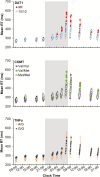Time-on-Task Effect During Sleep Deprivation in Healthy Young Adults Is Modulated by Dopamine Transporter Genotype
- PMID: 29029252
- PMCID: PMC5805243
- DOI: 10.1093/sleep/zsx167
Time-on-Task Effect During Sleep Deprivation in Healthy Young Adults Is Modulated by Dopamine Transporter Genotype
Abstract
Study objectives: The time-on-task (TOT) effect and total sleep deprivation (TSD) have similar effects on neurobehavioral functioning, including increased performance instability during tasks requiring sustained attention. The TOT effect is exacerbated by TSD, suggesting potentially overlapping mechanisms. We probed these mechanisms by investigating genotype-phenotype relationships on psychomotor vigilance test (PVT) performance for 3 a-priori selected genes previously linked to the TOT effect and/or TSD: dopamine active transporter 1 (DAT1), catechol-O-methyltransferase (COMT), and tumor necrosis factor alpha (TNFα).
Methods: N = 82 healthy adults participated in 1 of 3 laboratory studies. A 10-min PVT was administered repeatedly during 38 h of TSD. We assessed changes in response time (RT) across each minute of the PVT as a function of time awake and genotype. Additionally, cumulative relative RT frequency distributions were constructed to examine changes in performance from the first to the second 5 min of the PVT as a function of genotype.
Results: DAT1, COMT, and TNFα were associated with differences in the build-up of the TOT effect across the 10-min PVT. DAT1 additionally modulated the interaction between TSD and the TOT effect. Subjects homozygous for the DAT1 10-repeat allele were relatively protected against TOT deficits on the PVT during TSD compared to carriers of the 9-repeat allele.
Conclusions: DAT1 is known to regulate dopamine reuptake and is highly expressed in the striatum. Our results implicate striatal dopamine in mechanisms involved in performance instability that appear to be common to TSD and the TOT effect. Furthermore, DAT1 may be a candidate biomarker of resilience to the build-up of performance impairment across TOT due to TSD.
Keywords: catechol-O-methyltransferase (COMT); cognitive performance; dopamine active transporter 1 (DAT1); fatigue; mental workload; psychomotor vigilance test (PVT); striatum; total sleep deprivation; tumor necrosis factor alpha (TNFα); vigilance decrement.
© Sleep Research Society 2017. Published by Oxford University Press on behalf of the Sleep Research Society. All rights reserved. For permissions, please e-mail journals.permissions@oup.com.
Figures





References
-
- Davies DR, Parasuraman R.. The Psychology of Vigilance. London: Academic Press; 1982.
-
- Lim J, Kwok K. The effects of varying break length on attention and time on task. Hum Factors. 2016; 58(3): 472–481. - PubMed
-
- Hancock PA, Hart SG. Defeating terrorism: what can human factors/ergonomics offer?Ergon Des. 2002; 10(1): 6–16.
-
- McFadden SM, Vimalachandran A, Blackmore E. Factors affecting performance on a target monitoring task employing an automatic tracker. Ergonomics. 2004; 47(3): 257–280. - PubMed
-
- Caldwell JA. Fatigue in aviation. Travel Med Infect Dis. 2005; 3(2): 85–96. - PubMed
Publication types
MeSH terms
Substances
Grants and funding
LinkOut - more resources
Full Text Sources
Other Literature Sources
Miscellaneous

